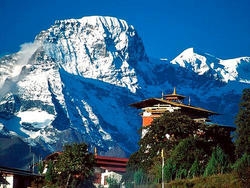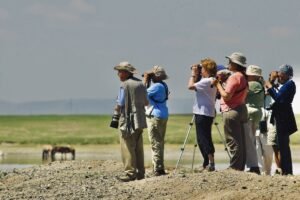Bhutan feels pressure to let more foreign visitors in

Thimpu : Saffron-robed monks wander the streets of Thimphu, where elaborately painted buildings feature lucky symbols such as tigers and phalluses, all under the gaze of a huge gold Buddha atop a mountain overlooking Bhutan’s tree-lined capital.
Premium-paying tourists have long eulogised Bhutan’s unspoilt charms, its peace and its pristine environment, but the Himalayan kingdom, famed as the “last Shangri-La”, and for using happiness to measure its success, is no idyll.
Its economy is struggling, with shantytowns emerging in urban centres, packs of wild dogs roaming freely and beggars on street corners.
Bhutan, wedged between India and China, spends far more on imports than it earns, banks are cracking down on cheap credit after a recent debt-driven spending boom, and youth unemployment has surged to 9.2 percent as teenagers abandon farming for urban life.
The government is trying to cut the number of people living below the poverty line to 15 percent of the population from its current 23 percent, according to its own official figures.
Encouraging more tourists would bring in cash, but the government will not abandon its long-standing policy of limiting visitor numbers by accepting only those who pay $250 (R2 131) a day in advance.
“Bhutan will never be a mass destination,” said Chhimmy Pem, the head of marketing at the Tourism Council of Bhutan, formerly the Department of Tourism, which implements the government’s tourism policy. “Our target will always be the high-end visitors.”
After paying for accommodation, travel, food and a guide, $65 of that $250 goes to the government. The policy was adopted to prevent tourism destroying Bhutan’s unique Buddhist culture and traditions, but some politicians say protection from the outside world is no longer needed.
“Tourism was a real threat in the past, but that threat has gone,” said Tshering Tobgay, the head of main opposition group, the People’s Democratic Party. An increasingly consumerist Bhutanese society, he said, was changing regardless of the influence of sightseers. “It is us Bhutanese ourselves who are now putting our traditions and culture at risk.”
Bhutan adopted a “high-end, low-volume” tourism policy when the reclusive nation opened its borders to foreigners in 1974. That year just 300 visited.
Last year, Bhutan welcomed about 64 000 people, according to figures released by the Tourism Council of Bhutan this month. By contrast, more than 600 000 people visited nearby Nepal in 2010, official Nepali figures showed.
In contrast to Nepal and India, where backpackers who live on a few dollars a day are welcomed, luxury resorts are more Bhutan’s style, attracting celebrities including Leonardo di Caprio, Cameron Diaz, and Jack Nicholson, who can go by unnoticed.
Management consultancy firm McKinsey was commissioned by Bhutan to look at its economy, and recommended in 2009 that the country should attract 250 000 tourists by 2014. The government, however, decided this target was too ambitious, and instead wants to bring in 100 000 a year by the end of the year.
Last year tourists paying in US dollars contributed $47.7 million towards the country’s direct gross earnings, up 32.5 percent from a year earlier.
Combined with visitor spending on extra services and handicrafts, the Tourism Council estimated that the industry contributed nearly 10 percent of the gross domestic product (GDP) last year, making it the country’s second-biggest earner.
Power exports, mainly to India, account for 40 percent of national revenue, and a quarter of the GDP, according to the Asian Development Bank.
Sonam Dorji, the secretary-general of the Association of Bhutanese Tour Operators, said early fears over the culturally and environmentally destructive effects of tourism had faded, but concerns over numbers had not.
“The tourists who come here are well travelled, and cultural tourism is their major interest, so they travel to the villages to see local festivals and stay in traditional homestays,” he said. “This brings money to local economies and supports these traditions which could die out otherwise.
“But we just can’t cope with much greater numbers. We couldn’t absorb them and provide a good-quality service. We are a developing country, but one of the least developed in the world and I don’t see that changing rapidly in the near future.”
About 70 percent of Bhutan’s 700 000 population survives through subsistence farming. Electricity and roads are yet to reach all of the country, and the latest Gross National Happiness survey, conducted in 2010, found that only 41 percent of Bhutanese were classified as “happy”.
In an interview with Reuters last month, Prime Minister Jigmi Thinley said Bhutan could not cope with the recent phenomenon of debt-fuelled consumerism which has outstripped economic output, forcing the government to cut spending and consider raising some taxes.
Bhutan has proudly marketed itself as the “The Land of True Happiness” since its fourth king famously adopted a mantra in 1979 that a happiness index, rather than orthodox economic indicators, was a better way to measure national progress. It was not until recent years that Bhutan actually came up with a way to measure this.
But Bhutan is a country in transition. The younger generation is abandoning traditional dress in favour of jeans, T-shirts and tattoos, and most young Bhutanese are on Facebook.
It is a major shift for a nation that only allowed television and internet access in 1999, and still bans the sale of tobacco.
This is where the tension lies: tourists, so important to the economy, enjoy the exclusivity of Bhutan, and they fear that if the pace of progress increases, they may find that the very things that draw them there are jeopardised.
“There are no queues here and tourism has not left a mark,” said American tourist Jennifer Logsdon, a human resources executive from Boston who was enjoying Bhutan’s ancient monasteries and fortresses dotted across the country.
“Unlike so many other places in Asia, you are not hassled in the streets here,” said Maryanne Paget, a holiday maker from Australia.
As well as the cost, limited access has kept numbers down.
National carrier Drukair is the only airline which flies to Bhutan, its planes leaving from Nepal, India and Thailand. Later this year it plans to add another Indian route, and start flying from Singapore.
One change the industry in Bhutan did want was to make tourism a year-round business, Sonam said, rather than relying on spikes in tourism during major religious festivals in spring and autumn, when costumed, masked dancers fill flights and hotels. At other times, many hotels are empty and gift shops do little trade.
Still, foreign travel agents say Bhutan should be wary of switching to an open-door policy.
“Bhutan still has that mystical appeal, and it would be very sad if it compromised the policy that was designed to stop it making the same mistakes as its neighbours,” said travel agent Charlotte Lawson from Britain’s Steppes Travel, which specialises in luxury and tailor-made trips.“It is an extraordinarily special place and should stay so.” Source: iol.co.za














